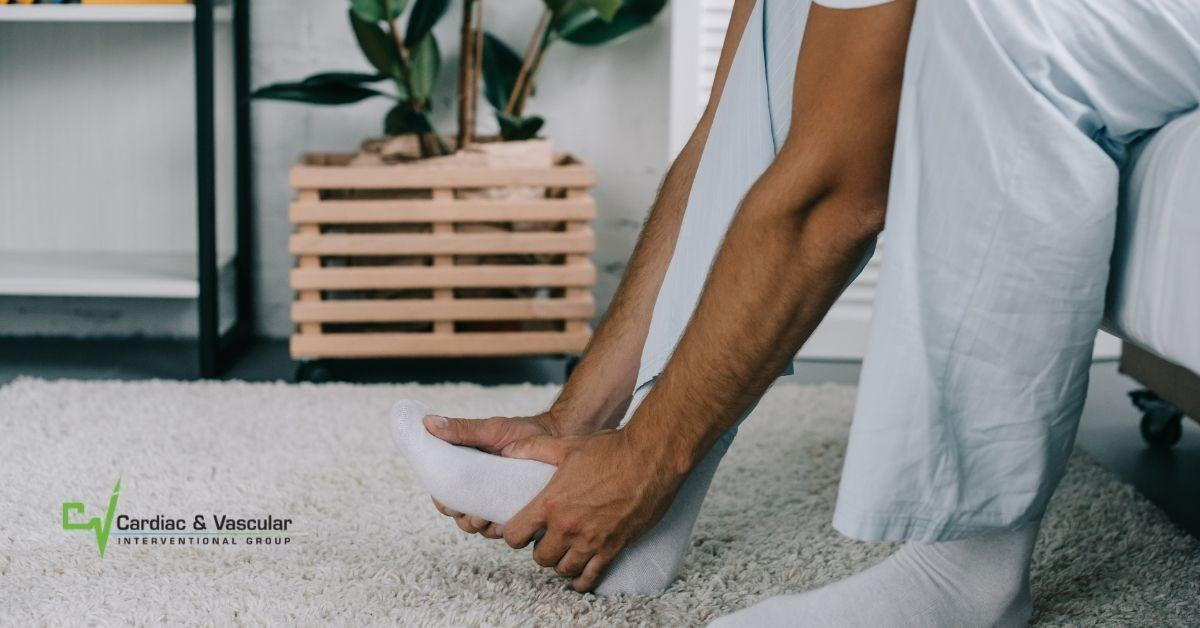Understanding Peripheral Artery Disease (PAD)

- posted: Jul. 01, 2021
Everything You Should Know About PAD
With more than 6.5 million Americans over the age of 40 living with peripheral artery disease, it is essential that those at risk for and affected by PAD understand the condition to prevent future health complications. The health experts at Cardiac & Vascular Interventional Group are here to share more information about this commonly overlooked vascular health issue.
What is Peripheral Artery Disease (PAD)?
Peripheral artery disease (PAD) is a vascular disease that is characterized by the narrowing and blockage of the arteries that carry blood away from the heart. Unfortunately, this can reduce blood flow throughout the body—especially to the feet and legs..
This vascular health issue is brought on by atherosclerosis, which means that there is a buildup of fatty plaque within the artery walls. If this blockage remains unaddressed, the plaque can become brittle and rupture, leading to the formation of a blood clot. This blood clot can further narrow the affected artery and can completely cut off blood flow.
Signs and Symptoms of PAD
People of color are disproportionately treated with amputation for PAD because their condition wasn't caught in time for other, non-invasive and effective, treatment options. In fact, many people mistake their PAD symptoms for other common ailments and in many instances, can even go undiagnosed by healthcare professionals.
The following signs and symptoms may suggest that you have peripheral artery disease:
- Fatigue
- Leg pain while walking
- Leg pain while resting
- Numbness in the leg
- A weak or absent pulse in the leg or foot
- A lower temperature in one leg compared to the other
- Wounds on the leg or foot not healing
- Slowed toenail growth
- Shiny skin on the legs
- Erectile dysfunction (ED)
It is important to keep in mind that having one or more of the above symptoms does not always mean that you have PAD. Be sure to speak with your primary care doctor to determine if you require further testing by a cardiovascular health specialist.
Risk Factors for PAD
Like most health conditions, there are certain factors that can leave you at an increased risk for developing PAD. The following controllable and uncontrollable factors for this vascular disease include:
Smoking and Using Tobacco Products
Smokers are three times as likely to develop PAD than nonsmokers. To effectively reduce this risk, it is advised that you either quit smoking or never start to begin with/
Type 2 Diabetes
Having type 2 diabetes that isn’t properly managed puts you at a higher risk for developing PAD and other cardiovascular diseases. Managing your diabetes is essential when it comes to preventing PAD and other cardiovascular health issues.
High cholesterol
Having high cholesterol levels in your blood can contribute to the fatty plaque deposits within your arteries. This makes managing your cholesterol levels vital to the prevention of PAD.
Leading an Inactive Lifestyle
Sedentary and inactive behaviors can increase the risk of cardiovascular diseases like PAD. It is recommended that adults get at least 150 minutes of moderate-intensity aerobic physical activity each week.
Fortunately, once diagnosed, PAD can be effectively managed. With the assistance of your cardiovascular care team, you can access personalized treatment and make the necessary lifestyle changes to prevent the progression of PAD and alleviate uncomfortable symptoms.
Cardiovascular Care in Dallas
At Cardiac & Vascular Interventional Group, we are committed to applying our clinical excellence and expertise to treating patients of all backgrounds. With the skilled guidance of our acclaimed providers, we are keenly focused on the care of the community. Our practice specializes in the treatment of coronary artery disease, peripheral artery disease, and structural heart disease.
To learn more about our cardiovascular services or to schedule an appointment fill out an online contact form or call (469) 437-3560.
Contact Us
Plan Your Visit
425 S Llewellyn Ave,
Dallas, Texas 75208, US
(214) 946-7445
